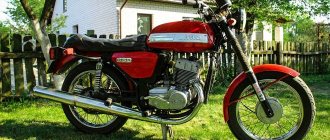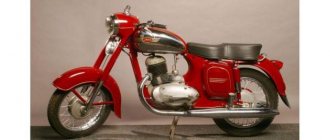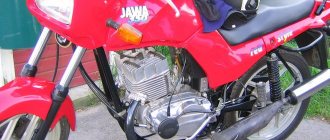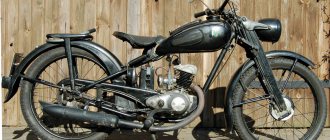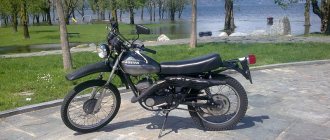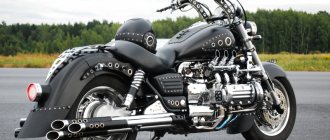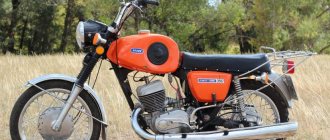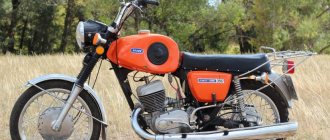Izh motorcycles, from the first models to the present day
Izh originate their history in the distant 30s of the last century. In 1928-1929, drawings and prototypes of the first motorcycle models were developed: Izh-1, Izh-2, Izh-3, Izh-4 and Izh-5.
The first models of Izh motorcycles
D
These models were produced in a special workshop of the Izhevsk arms factory. Just a few months before the start of the All-Union Motorcycle Ride, engineers and designers managed to develop as many as five models of motorcycles to participate in this motorcycle rally.
Unlike various models of that time, the design and structure of the first Izh motorcycles were quite original and innovative. Three-speed gearbox, mainly V-shaped engines with displacements of 500, 750 and 1200 cubic centimeters, thrust to the drive wheel was transmitted via the crankshaft, with the exception of the Izh-3 model, the thrust on which was transmitted by a chain. A strong stamped frame, the lower part of which served as a protective housing for the muffler (this feature is inherent in all models of the first prototypes of motorcycles from the Izhevsk plant), the front fork combined parallelogram and lever designs at the same time.
All five motorcycles took part in the 2nd All-Union Motorcycle Rally, which took place from September to October in 1929. It’s surprising that in their first run, IZh motorcycles easily crossed the 3,000-kilometer mark.
However, this story was not continued immediately, since after the end of the motorcycle rally, the Izhevsk plant received a very large order. This led to the fact that chief engineer P.V. Mozharov, who developed the drawings and general design for all five first models of Izh motorcycles, moved to Leningrad. There he began developing a new motorcycle, called the L-300. He based the new development on the drawings of a German company, which he brought from Germany after completing an internship abroad.
Start of serial production of Izh motorcycles
A key moment in the history of motorcycles at the Izhevsk plant was the decision of experts from the Presidium of the Supreme Economic Council of the USSR that a large domestic motorcycle plant should be built in Izhevsk. The city had all the necessary facilities and highly qualified specialists for this.
Some time later, on the basis of the weapons factory on Bazarnaya Street, the creation of the Experimental Motorcycle Plant began. By the beginning of May 1933, the newly built plant produced 4 NATI-A-750 motorcycles, developed by the same Mozharov. At the same time, work was underway to continue the line of Izh motorcycles, the first step towards which was the Izh-7 motorcycle, based on documents and drawings brought from Leningrad. These were practically copies of the L-300 model, with a 2-stroke 1-cylinder engine, a three-speed gearbox, a chain drive and the already familiar stamped frame. Ultimately, the Izh-7 turned out to be one of the most successful models developed during the launch of the plant and was chosen as the flagship intended for mass production. In 1934, the motorcycle plant gained momentum and already produced 111 motorcycles.
For four years in a row, until 1938, the Izh-7 motorcycle was a favorite. However, it was replaced by a new model in the form of the Izh-8. They improved the ignition system and electrical wiring, and also improved the technical characteristics of the 300 cc engine, due to which its power increased to 8 hp. Two years later, in 1940, production of the Izh-9 model began, the engine power of which was already 9 hp. In the same year, documents and drawings of the L-8 motorcycle arrived from Leningrad, which was already equipped with a 4-stroke engine with a displacement of 348 cubic meters and a power of 13.5 horsepower. Izh motorcycles received a new lease of life and to develop a new model they decided to use the chassis from the Izh-9 model. The resulting motorcycle was named Izh-12, production of which was to begin in the summer of 1941. However, the outbreak of war stopped the further development of the motorcycle industry.
Post-war period in the history of Izh motorcycles
In 1946, the plant restored its operations and its capacity, having received German drawings, technologies and equipment taken from Germany after its defeat. Work begins on the production of a new model Izh-350, based on the German motorcycle model DKW-350. After adaptation to Soviet electrical appliances and equipment, the motorcycle turned out to be modern and at the same time quite simple for that time. The motorcycle began to be assembled at a weapons factory.
From the 40s to the 60s, Soviet designers made a significant leap in the creation of sports motorcycles. Even though they were based on completely road and factory models, the results were amazing. So, in 1948, the Izh-350S motorcycle was developed and produced, which received a telescope fork, in contrast to the already outdated parallelogram fork. The suspension and technical characteristics of the engine also improved, which gave an increase in power, which increased and reached 14 horsepower. The fifties were rich in innovations in development, so the Izh-49, Izh-50, Izh-54 and Izh-55 models were developed. The power of Izh motorcycles also increased, up to 18 horsepower.
In 1962, production of the Izh Planet motorcycle began, which was maximally unified with the Izh-Jupiter model. Innovations in the use of materials and design of piston group parts, with the help of a contact-oil air cleaner, increased the service life of the cylinder and piston group parts by more than one and a half times. During the 70s, the Izh Planeta-2, Izh Jupiter-2, Izh Planeta-3, Izh Jupiter-3, Izh Jupiter-3K and Izh Planet Sport motorcycles were developed. The most striking achievement of the designers was the Izh Jupiter-3 motorcycle, the power of which increased by almost 40% in comparison with its predecessors. The Izh Planeta-3 and Izh Jupiter-3 models received the USSR state quality mark and in 1975 they were already producing 250 thousand motorcycles per year.
Over the next twenty-five years, the Izhevsk Motorcycle Plant increased its capacity, improving existing models and developing new ones. In 2000, the first Izh motorcycle in the chopper style appeared in the factory version. It was Izh 6.113-05 Junker.
Later, in 2008, due to great economic difficulties, the IZhMoto enterprise was mothballed, most of the plant’s capacity was sold to help pay debts to creditors.
PS In 2009, namely in September, IZhMoto had a big date. Exactly 80 years since the release of the first Izh-1 motorcycle.
The complete history of IZH motorcycles
Source
Scoopcycles
Today marks exactly 91 years since the Izh-1 motorcycle left the gates of Izhstalzavod. This date, September 17, 1929, is considered to be the birthday of the Izh motorcycle! Happy holiday, friends! On Izh’s birthday, it’s time to remember where it all began! And of course, tell everyone about it. Below the cut is a story about the appearance of the first five Izhas (Izh-1 - Izh-5) in 1929.
The initiative to produce motorcycles in Izhevsk was taken by the talented heating engineer Pyotr Vladimirovich Mozharov. He was, perhaps, one of the most experienced motorcyclists in the USSR at that time - according to him, while studying in Germany (1911-1914), he traveled more than 60 thousand km on motorcycles of more than 20 brands, participated in more than 10 different motorcycle races .
P.V. Mozharov near NATI-A-750, Izhevsk, 1933
It all started with the Izh-3 motorcycle. At the beginning of the summer of 1928, Mozharov P.V. gave the drawings of the first motorcycle for production. How did he turn out?
One of the main foundations of a motorcycle, in addition to the engine, is the frame. On the Neander, chosen as a prototype, the frame was stamped, had high strength and low weight. But for large-scale production it had a huge drawback: it was expensive, because it consisted of 16 complex stampings and staple-shaped strips connected by 70 rivets in hard-to-reach places. The result of research by P.V. Mozharov became a frame consisting of two symmetrical stamped welded halves, made of 3 mm thick steel, with bent sides. This design made it possible to accommodate an engine with a volume of up to 1200 cm3.
A parallelogram-type fork with a central spring of variable coil diameter was used as the front suspension, which increased its efficiency. In the 20s, this type of fork was used only on some high-speed motorcycles. The lower part of the frame was used as mufflers. To increase comfort, a sprung “cavalry type” saddle was installed in the center of the wheelbase - that is, at the point of least shaking of the motorcycle. The steering handles were equipped with special protective brackets, to which, if necessary, casings could be quickly attached to protect from rain and wind.
How resistant do you think this speedometer drive is to a mud bath?
According to the tradition of that time, the motorcycle was equipped with stands for the front and rear wheels, mounted under the wings on the wheel axles. But, according to Mozharov’s observations, during the runs the motorcycle had to be placed on a stand 40-60 times a day, which greatly tired drivers of heavy vehicles. Therefore, an additional side stop was installed, for which Pyotr Vladimirovich filed a patent application in 1927 in Germany.
Article by P.V. Mozharova about Izh-3, magazine “Behind the Wheel”, 1929
The gas tank was located between the sides of the frame, which protected it during falls. Main tank volume: 18 l, reserve tank: 5 l. This made it possible to have a power reserve of 300 km. The carburetor was moved out of the dusty area of the front wheel, and an improved Pallas filter was installed on it. Also, due to the virtual complete absence of highways, the drive chain was placed in a sealed housing and was in an oil bath. The open circuit between the gearbox and the engine (a typical design of motorcycles of those years) was eliminated by connecting the gearbox to the engine crankcase.
To reduce the amount of development, the engine was installed from a 750 cc Wanderer motorcycle. This motorcycle was manufactured at the beginning of 1929, and its testing began in the spring. Later the motorcycle was given the name... Izh-3. I’ll tell you why exactly 3 a little later.
Technical characteristics of Izh-3 Year of production: 1929 Engine: 2-cylinder, V-shaped, 4-stroke, overhead valve. Volume: 750 cm3 Power: 29 hp at 3600 rpm Gearbox: 3-speed Ignition: magneto Wheels: 26x3.25 Wheelbase: 1300 mm Ground clearance: 110 mm Weight: 180 kg (without sidecar) Gas tank volume: 18 l (main), 5 l (reserve) ) Power reserve: 300 km. Final drive: multi-roller chain in a sealed casing and oil bath
But the Izh-1 engine is worth talking about separately. In mid-September 1928, Pyotr Vladimirovich Mozharov returned to Izhevsk from Moscow, where the finish of the First All-Union Motorcycle Race took place (I’ll tell you about the race a little later). During the run, Pyotr Vladimirovich became acquainted with various designs of motorcycles, their work under operating conditions on roads and off-roads of the USSR. How was the experience of the 1928 run used?
In this run, Pyotr Vladimirovich saw with his own eyes that it was impossible to create a universal motorcycle for such a large country as the USSR. Therefore, the motorcycle section decided to develop a larger number of motorcycles (initially only light and heavy ones were planned) with various technical solutions, and these solutions were to be tested in the next run. At that time, the army and the national economy were in dire need of heavy motorcycles, so in September 1928 they began precisely this project.
We started with designing a 1200 cm3 engine. Mileage experience has shown that the engine cylinders, on the one hand, should be well cooled, because in off-road conditions you often have to move in lower gears, which eliminates the use of a transverse V-twin (the air flow on the rear cylinder is much less than on the front), which is found on motorcycles such as Harley Davidson and Indian. On the other hand, the cylinders must be placed high above the ground, which limited the use of the boxer design (motorcycles like BMW). There seemed to be two more schemes left: a single-cylinder and an in-line engine. A single-cylinder for such a volume, of course, was not even considered (vibration level and uneven operation). It was decided to abandon the in-line transverse engine, since it would be difficult to implement a cardan drive to the rear wheel, which has great advantages in protection from dirt compared to a chain, and the in-line longitudinal engine again did not provide sufficient cooling. Therefore, we came to the design... of a longitudinal V-twin. I don’t know if such a scheme was found on any other motorcycles of those times, but it certainly wasn’t very popular. On Moto Guzzi such an engine began to be used only in the 60s.
For better cooling, the crankcase of the Izh-1 engine and gearbox was also made with fins. The clutch was released using the left handle on the steering wheel, or a pedal with a rod on the left side. The characteristics of the resulting engine are presented below:
Type: 4-stroke, overhead valve, longitudinal V-twin. Power: 24 hp at 3000 rpm. Cooling: air, free air flow Number of gears: 3
So, the main transmission of all the first Izhs (except Izh-3), for the successful fight against “Izhdryaz”, was a cardan. The frame consisted of two solid trusses welded together. Together, the engine and frame formed a rigid spatial structure. The gas tank was inserted into the frame from above, remaining protected by the frame that wrapped around it. The passenger was placed in a stroller, and a spare wheel was also located there. All wheels of the first Izh were interchangeable. Since it was intended to ride without a sidecar, the handlebars were equipped with two cone-shaped shields and a closed steel tube (analogous to modern hand protection on enduro motorcycles). The steering wheel was connected to the fork through spring shock absorbers.
The design of the front suspension is no less interesting - separate systems were used to dampen wheel vibrations in the longitudinal and vertical directions. The suspension was made of springs. However, this design did not allow it to develop more than 65 km/h - the motorcycle would wobble (uncontrollable increasing vibrations of the steering wheel). But, as Mozharov said: “More suicide on our roads.”
Izh-1, photo 2004
Why was there first Izh-3, and then Izh-1? In order to get to the heart of the matter, we’ll tell you a little about the Izh-2.
Immediately after the completion of work on the Izh-1, the idea of creating a modification of this motorcycle appeared. So, on the Izh-2, one of the vibration damping systems of the front suspension was removed, the protective shields for the driver’s hands were removed, a high windshield was installed on the stroller, which now accommodated as many as 2 passengers (thus the Izh-2 became a 4-seater, second place the stroller was in the trunk), side cases were installed, the frame was reinforced, but the main feature of the Izh-2 compared to the Izh-1 was the use of forced air cooling and a drive to the stroller wheel, which made it possible to successfully move on bad roads for an unlimited time.
These design changes led to the fact that this particular motorcycle became the only one that, on September 19, 1929, was able to overcome 30 km of muddy roads to the Golyany pier on the Kama River under its own power - the rest of the motorcycles were forced to be loaded onto carts, as the mud was soggy after the autumn showers they were only able to move in first gear, and as a result quickly overheated. True, the road exhausted the driver so much that upon reaching the pier, he got up from the motorcycle and, exhausted, fell.
And yet, why did the first Izh become the third (Izh-3), and the second - the first (Izh-1). Here Pyotr Vladimirovich reasoned as follows: heavy motorcycles (Izh-1, Izh-2, 1200 cm3) are of paramount importance for the army, and besides, the Izh-1 was supposed to make the greatest impression (which, in general, was confirmed: to this day Since then, the Izh-1 has admired many, and then, for example, it amazed the Japanese, who reported to their government that the USSR had created a formidable military motorcycle), the Izh-3 (750 cm3) was a middle-class car, while the light Izh-4 (200 cm3) was seen as a “people's motorcycle”, which was supposed to bear the burden of motorizing the USSR, and the Izh-5 and Izh-6 were intended to test foreign units and some experimental solutions in the USSR.
Technical characteristics of Izh-1 and Izh-2: Type: 4-stroke, lower valve, longitudinal V-twin. Power: 24 hp at 3000 rpm. Cooling: forced air (Izh-2), ram air (Izh-1) Gearbox: 3-speed Weight without sidecar: 300 kg. Type of final drive: cardan, + according to some sources on the Izh-2, drive to the sidecar wheel Number of passengers: 3 + driver. Year of production: 1929 Ignition: magneto Wheels: 27x4 Wheelbase: 1400 mm Ground clearance: 120 mm Weight: 300 kg (without sidecar) Gas tank volume: 16 l
Heavy motorcycles were of paramount importance for the army, where the cost of equipment and technical superiority of solutions is very high. But the means of motorization of the entire Union should have been motorcycles of a different type - lightweight, cheap to purchase and maintain, accessible to a wide segment of the population. It is especially worth mentioning the state of the road and automobile sector in the 1920s, when in some areas there were simply no carts, and drags were used to transport goods, and the roads were just a trace of these drags.
In such conditions, when “the condition of most of our roads forces us to consider 60-70 kilometers per hour as the maximum speed, crossing the boundaries of which is tantamount to suicide” and when “driving a car on a rider is a normal phenomenon” (see quotes in the article), the most advantageous option should be to become precisely a light motorcycle, which has already become the most widespread in Western Europe.
However, despite the requirement for a cheap motorcycle, the model was still equipped with a cardan drive with two elastic couplings, because this design is characterized by “unlimited service life and is not comparable to a chain in terms of minimum maintenance.” The motorcycle frame is stamped and welded, and the engine, to save design time, was used 1-cylinder, 2-stroke 200 cm3 from the German company Stock. The gas tank capacity of 10 liters provided a range of 250-300 km. Since the destructive effect of dust on a 2-stroke engine is especially great (due to the passage of the mixture through the crank chamber), a large self-cleaning air filter was used. The platforms were made tipping over to avoid breakage during falls.
Technical characteristics of Izh-4 Year of production: 1929 Engine: 1-cylinder, longitudinal, 2-stroke, with three-channel purging. Volume: 200 cm3 Power: 4.5 hp at 3500 rpm Gearbox: 2-speed, interlocked with the engine in one crankcase Ignition: from a BOSCH magneto Wheels: 26x3.00 Wheelbase: 1100 mm Ground clearance: 110 mm Weight: 100 kg Gas tank volume: 10 l Power reserve: 250-300 km. Final drive: cardan with two elastic couplings Front fork: parallelogram with central conical spring Clutch: multi-plate in oil bath
In the summer of 1929, drawings of motorcycles of all classes were already ready: heavy (Izh-1, Izh-2, 1200 cm3), medium (Izh-3, 750 cm3) and light (Izh-4, 200 cm3). Then it was decided to make two more experimental motorcycles to test the operation of some components from foreign cars. So, on the Izh-5 it was planned to install a 4-stroke single-cylinder engine with a volume of 400 cm3 and a power of 8 hp, and the frame, gas tank, saddle and handlebars would be taken from a Neander motorcycle, the main gear type would be chain. Another interesting feature of the Izh-5 is the use of a modified P.V. Mozharov's lever front fork, and the fact that the motorcycle did not have central stops. But a side folding stand was used, a patent application for which by P.V. Mozharov filed in 1927 in Germany.
The designer saw the Izh-6 motorcycle like this: a stamped frame, a single-cylinder 4-stroke engine, a driveshaft for the rear wheel, a soft spring fork. However, the pace of work of the motor section on these motorcycles (Izh-5 and Izh-6) was insufficient due to the continuation of the production of Izh-1, Izh-2, Izh-4. The plant management had no final confidence that the Izh-5 and Izh-6 would be ready for the run (the start of which was pushed back to September 25 from Moscow as much as possible), so 12 motorcycles were officially announced for the run, among which were the Izh- 1, Izh-2, Izh-3, Izh-4 and foreign cars, to compare the driving performance of motorcycles.
As a result, Izh-5 still managed to start its run, but work on Izh-6 progressed very slowly. No photographs of the Izh-6 have survived, and its fragments were lost in 1932 (most likely they were used as spare parts for other motorcycles), but a sketch by P.V. Mozharov motorcycle NATI-V-375, on the nameplate of which there was the inscription: “Izh-6”. The reason for this is the almost complete similarity between the Izh-6 and NATI-V-375.
Technical characteristics of Izh-5 Year of production: 1929 Engine: 1-cylinder, 4-stroke. Volume: 400 cm3 Power: 8 hp at 400 rpm Gearbox: 3-speed, articulated with the engine Ignition: magneto Wheels: 26x3.25 Wheelbase: 1300 mm Ground clearance: 120 mm Weight: 130 kg Gas tank volume: 10 l Final drive: chain Front fork: pendulum Frame: stamped, double
On the rainy morning of September 17, 1929, the Izh-1 motorcycle solemnly left the gates of Izhstalzavod. This date is generally considered to be the birthday of the Izhevsk motorcycle (although the Izh-3 was tested in the spring, and as the first-born it was given number 1 in the run). Joseph Shadrin had the honor of being the driver of the Izh-1, and, according to eyewitnesses, almost immediately after leaving the factory gates, he began adjusting the carburetor. At this time, the remaining members of the motorized section were hastily finishing the Izh-2, Izh-4 and Izh-5 - the departure for the run along the route Izhevsk-Gorky-Moscow-Leningrad-Vitebsk-Kharkov-Oryol-Moscow was scheduled for the next day.
Ceremonial departure from the gates of the plant, Izh-1, September 17. 1929
Motorcycles Izh-1 and Izh-4 are currently in the Izhmash Museum.
